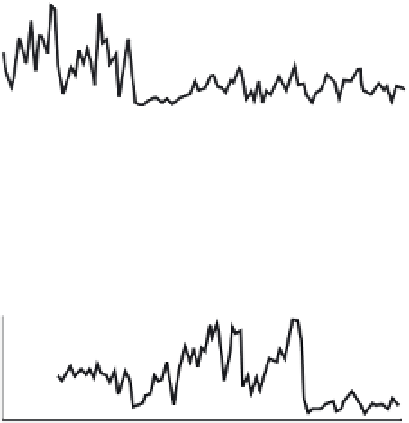Geology Reference
In-Depth Information
A rather different technique has been applied
in some areas where faults pass through forested
landscapes. During the sudden displacements
that occur in an earthquake, the roots of trees
growing along the fault line are often disturbed
and can be sheared off or the trunk itself may be
cracked (Plate 2D). If ground shaking is suffi-
ciently vigorous, some trees can literally have
their crowns shaken off. The branching pattern
of such trees can indicate that they lost their
crowns at some time in the past: the main trunk
abruptly ends and forks into lesser trunks, so
that it looks like a tuning fork. Clearly, any of
these events (breaking off the roots, splitting the
trunk, or lopping off the top) traumatize a tree.
In response to such a disturbance, the rate at
which a tree grows can plummet ( Jacoby
et al.
,
1988; Sheppard and White, 1995; Van Arsdale
et al.
, 1998). One could imagine, therefore, that
by simply examining the temporal pattern of
annual ring widths produced by trees growing
adjacent (
±
20 m) to a major fault, one might be
able to discern past earthquakes as represented
by times of decreased ring widths.
Unfortunately, analyzing ring widths is some-
what complicated (see Chapter 3), because ring
widths are also a sensitive function of climatic
conditions. In fact, most studies of tree rings
have been undertaken in an effort to reconstruct
past climate. Many factors affect ring widths,
including moisture availability, air temperature,
and seasonal variability. In general, when trees
are stressed, they produce narrow rings (little
growth). So, how does one separate narrow
rings following earthquakes from those formed
in response to climate variations? The solution
requires a two-step procedure. First, a master
tree-ring chronology has to be developed for an
area (Fig. 6.24). This time series would represent
the average ring-width variation for trees not
located on the fault and would be interpreted as
the climatically induced signal. Second, the
ring-width chronologies from trees growing
along the fault are compared with the master
chronology. Parts of the record that display dis-
tinct mismatches and, in particular, prolonged
intervals of reduced ring width with an abrupt
beginning, can be interpreted to have resulted
from past earthquakes (Fig. 6.24). Whereas
Tree-Ring Records of Past Earthquakes
Wrightwood master
tree-ring chronology
2
1
0
1780
1800
1820
1840
1860
1880
5
Tree 1
abrupt drop
2.5
0
1780
1800
1820
1840
1860
1880
year of drought
8
Tree 2
year of earthquake
4
0
1780
1800
1820
1840
1860
1880
10
Tree 3
5
0
1780
1800
1820
1840
1860
1880
Year
Fig. 6.24
Tree rings as seismic recorders.
Tree-ring time series near Wrightwood, California, along
the San Andreas Fault. The master tree-ring chronology
portrays the climatically induced variations in ring
widths as determined from a regional synthesis of many
trees unaffected by faulting. A low index corresponds
with narrow rings (low growth) and correlates with
years of drought (marked by open arrowheads).
Ring-width chronologies for trees 1 to 3 display an
abrupt decline in ring width (to lower than any
previously formed ring) in 1812-13. Although this year
also corresponds to a year of drought, the accentuated
decrease in ring width and the long period of recovery
after 1813 indicate that an earthquake, rather than
climate, caused the tree to be highly stressed. These
data provide the first clear evidence that the earthquake
of 1812 (known primarily from coastal records) actually
occurred along the San Andreas Fault. The better known
San Andreas earthquake of 1857 (Ft.Tejon earthquake)
is also well represented in trees 2 and 3, thereby
suggesting that the 1857 rupture propagated at least this
far south. Modified after Jacoby
et al.
(1988).
climatic conditions change on a year-to-year
basis and ring widths responding to climate
show similar year-to-year variability, recovery































































































































